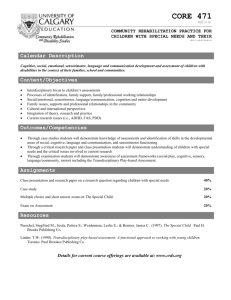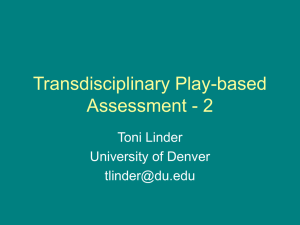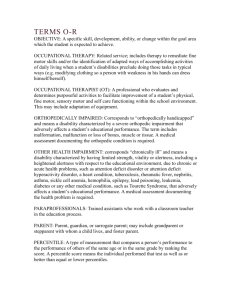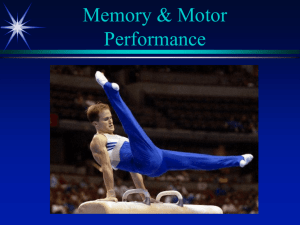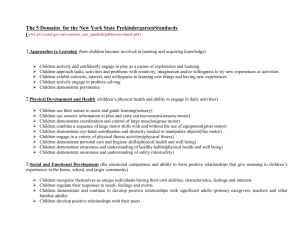TPBA: Transdisciplinary Play-Based Assessment Guide
advertisement
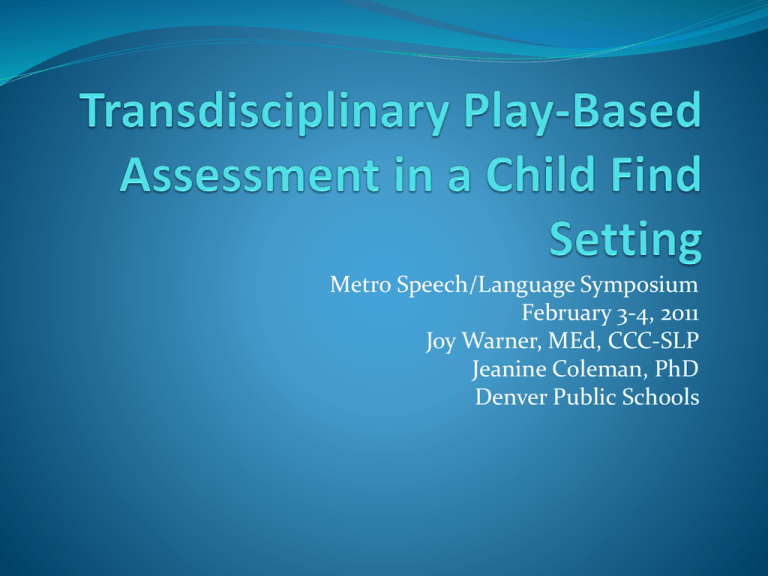
Metro Speech/Language Symposium February 3-4, 2011 Joy Warner, MEd, CCC-SLP Jeanine Coleman, PhD Denver Public Schools Goals of the Presentation Participants will: Gain understanding of the TPBA process with Child Find teams. Will observe best practices in assessment process. Learn facilitation strategies. Gain understanding of how to create functional, family sensitive goals and recommendations. Characteristics of the TPBA Play-based Dynamic Functional Flexible Authentic Multi-dimensional Collaborative Child & Family focused Strengths based Sensitive to child and family differences Purpose of TPBA To determine eligibility for Part C and Part B special education services and write Individualized Family Service Plans (IFSP) or Individualized Education Plans/Programs (IEP) To identify intervention strategies or intervention plans specific to individual children Progress monitoring Type of assessment “TPBA is an authentic process that involves observing the child in play situations with structured and unstructured facilitation of sensorimotor, social-emotional, language and communication, and cognitive development” (p. 8). TPBA is not a standardized, norm-referenced assessment TPBA is not a criterion-referenced assessment TPBA is not a developmental checklist TPBA is an assessment process that uses multiple sources of information across settings to determine strengths and needs of children. Systematic, observational data used to determine eligibility for services Developmental domains assessed Cognition Speech & Language Gross & Fine Motor Sensory Emotional & Social Adaptive INTERRELATEDNESS Results in quantitative and qualitative information Skill level Learning style Interaction patterns Contexts for development Intervention objectives and strategies Rating Scale Defining Transdisciplinary Teams Teams working together to assess children across disciplines Exchanging of roles or role release Flexibility Collaborative Integrative Effective Supportive Results in holistic evaluations Roles of team members Child Family (parents, grandparents, caregivers) Play facilitator—person who plays with the child Family facilitator—person who observes with the parent and discusses assessment processes Videographer—person recording the assessment Observers/note-takers—the rest of the team that observes and takes notes during the assessment on TPBA forms Other Team members SLP—Speech/Language Pathologist ECSE—Early Childhood Special Educator or Developmental Specialist OT/PT—Occupational/Physical Therapist School Psychologist Social Workers Nurse Audiologist/Hearing Specialist Vision Specialist Early Childhood Teachers and classroom assistants Child care provider Who is assessed? Children birth to 6 years Children who have previously be labeled “untestable” Children with short attention spans Children with limited mobility Children with social-emotional problems Children with autism Children with genetic disorders Children who are developing in a typical manner Children who may be gifted Children who are at risk for developmental delays Components Information from parents Observations of the child TPBA2 Observation Guidelines & Age Tables Analysis & discussion of information to get a holistic view of the child Program planning & recommendations for intervention (next steps) TPBA Process—what’s involved? Before the Evaluation Obtain information from families related to developmental, health, and social history of the child and family Obtain information from families and caregivers related to how they view the child’s development, behavior, and interactions within daily routines During the Evaluation Obtain information from caregivers as they observe the child during TPBA in order to determine how the child’s behavior during the assessment is similar or different from what they typically see Obtain information from team members who observe the child at play regarding developmental skills, behaviors, processes, learning style and interaction patterns After the Evaluation Integrate and share information in a post-assessment discussion with family members Write a comprehensive, holistic report that reflects the perspective of the family and the professionals involved in the evaluation; identifies a disability, delay, or concern through the assessment process; specifies global service needs; and provides specific recommendations that address: What skills, behaviors or processes the child is “ready for” and why How the “next steps” can be addressed Examples of activities or experiences from home and/or school that will support learning (pp.8-9) Family Facilitation Before, during, and after TPBA Listen to the story Identify concerns Provide information On TPBA Family’s role Obtain additional information Compare child’s behaviors at TPBA session & home Identify priorities of the family Use cultural responsiveness and sensitive communication skills Toys & Materials 1. 2. 3. 4. 5. 6. 7. 8. 9. 10. A full range of categories of play Familiar & unfamiliar experiences Simple and challenging problem-solving opportunities Varying types of mild to intense sensory stimulations Independent and social play opportunities Communication opportunities Opportunities for fine motor skills Opportunities for gross motor skills Opportunities to use pre-academic skills Means for addressing specific referral questions Structure of the TPBA Session Balance between observation of child’s independent play, spontaneous behaviors, following the play facilitator’s lead, structured facilitation, and responding to limits Parental (or caregiver) play with the child in both unstructured and structured interactions (e.g. sharing a snack, reading a story, completing a puzzle, or playing a game) Separation from and reunion with parents (or caregivers) Child-to-child interactions with siblings and/or peers Unstructured and structured motor play Inclusion of natural events (e.g. snack, toileting, dressing/undressing with outer clothing) Contrived events or situations to elicit questioned skills or behaviors (e.g. tantrums) Natural & Contrived Events Watch for key events: How the child enters the new environment Responds to new people or the presence of a group Interacts/plays with new toys and materials Transitions from one activity to another Deals with challenging tasks and unsuccessful attempts Responds to limits from parents and/or play facilitator Handles unexpected sensory input Tolerates brief separation from caregivers Handles having to stop playing with a toy/materials Responds to unexpected events or stimulation (e.g. someone new enters the room, loud noises) Play Facilitation Watch & wait: Do nothing, say nothing Assist as little as possible, but prompt, suggest, or provide physical support as needed Imitate the child Take turns with actions and/or communication Model actions or language and motive the child to engage with materials Oral & non-oral communication includes open-ended questions, fewer questions, and more comments Read cues and respond immediately to all initiations (language or actions) Enthusiasm is contagious! Play Facilitation—Adaptations Changing the facilitator Changing the environment Adapting toys & materials Positioning materials Positioning child Modifying sensory input Using assistive technology Using therapeutic strategies Observing Kassandra Communication Development Language comprehension Language production Pragmatics Articulation/phonology Voice & fluency Oral mechanism Hearing Emotional & Social Development Emotional expression Emotional/style/adaptability Regulation of emotions & arousal states Behavioral regulation Sense of self Emotional themes in play Social interactions Sensorimotor Development Functions underlying movements Gross motor ability Arm & hand use Motor planning & coordination Modulations of sensation and its relationship to emotion, activity level, and attention Sensorimotor contributions to daily life and self-care Vision Cognitive Development Attention Memory Problem solving Social cognition Complexity of play Conceptual knowledge Literacy Our DPS TPBA Tools Cheat Sheet Observation Notes Summary Form TPBA—Cheat Sheet of Play Activities Pretend/Symbolic Play Skill Activity Baby play—feed, dress, ID body parts, put to sleep, comb/brush the hair Kitchen play—stir the food, sort the food, set the table, counting Play with small figures Sensory Play Water, beans, rice, play dough, other sensory toys dumping-filling counting scoops hiding toys matching Present the book upside down Read a short story, pause at the end of sentences Point or name pictures Colors Shapes Animals Utensils Big/small; tall/short; open/shut; etc. More/less Give me one/two/all/some Rote counting One-to-one correspondence Cardinality Stacking blocks Imitating block designs—train, bridge Scribbling Vertical/Horizontal lines Circle with an end point Draw a person Cutting/snipping with scissors Folding paper to make a book Nesting blocks Cause-effect toys Wind-up toys Musical instruments Opening containers/twisting tops off Stringing beads Creating problem-solving situations Puzzles—one-piece/multi-piece/interlocking Find hidden toys Give 1-2-3 step directions Play with Books Sorting/Matching Concepts Numbers & Counting Block Play Writing/Drawing/Cutting Problem-Solving (including fine motor manipulation) Memory DPS Observation Notes Speech/Language—TPBA2 Age: Expressive: Cognitive/Educational—TPBA2 Age: Attention: Memory: Problem-solving: Social Cognition: Complexity of Play: Conceptual knowledge—emerging math& literacy: Speech/Language—TPBA2 Age: Receptive: DPS Observation Notes Gross Motor—TPBA2 Age: Fine Motor—TPBA2 Age: Social/Emotional—TPBA2 Age: Behavior/Temperament/Self-Regulation: Social Interactions: Sense of Self/Emotional themes in play: Adaptive/Self-Help—TPBA2 Age: Dressing: Sleeping: Feeding: Bathing: Toileting : Safety: Health concerns/issues: Vision/Hearing Screening: Sensory Processing—TPBA2 Age: DPS TPBA Summary Form Rating 4 Definite Concern (severe) 34-50% delay 3 Concern (moderate) 25-33% delay 2 Watch (mild) 10-24% delay 1 Typical 0-10% delay Cognitive Speech/Language Expressive Receptive Physical Motor Gross Fine Sensory Processing SocialEmotional Adaptive/Self -Help Physical Health Analysis of Observations Identify a range of skills observed—highest & lowest Identify the” mode” or age range that is most frequently observed Identify “splinter skills” Identify qualitative aspects of skills, behaviors, learning styles, interactions and what supports are needed. Use caution when sharing developmental age levels with parents Templates for Writing Recommendations Interventionist’s Thought Process: What is child doing now? What skills or experiences is the child ready for? and WHY? Give specific examples for home and/or school Templates for Writing Recommendations He is currently doing…. And therefore he is ready to … OR he is ready for more…. In order to develop….she will benefit from….. Activities to encourage….include…… Adaptation of …will allow her to….. Stimulation of …..using….will….. Questions & Sharing Life is not a race, but a journey.

